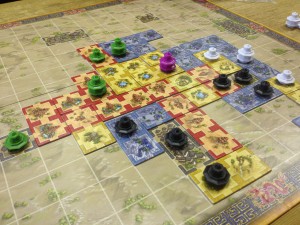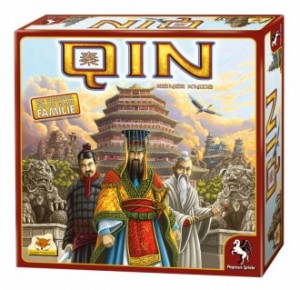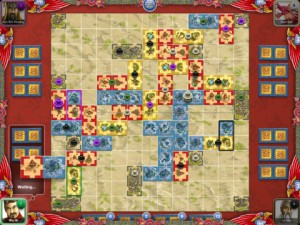Review: Qin
Posted by James (admin) on July 15th, 2013

Note: The right-hand village should be owned by the white pagoda player as there are 3 white pagodas connected to it compared to 2 black pagodas.
Qin is a tile-laying game with a Chinese theme by Reiner Knizia. The winner is the first player to place all of their pagodas and players place pagodas on coloured territories they have created, so the game is about area control.
Players take turns placing 1 of the 3 tiles in their hand on the board next to any of the existing tiles. Each tile has 2 squares on it and each square can be red, yellow or blue. If a player creates a new contiguous territory of any single colour that consists of 2 squares or more, then they can claim that territory and place one of their pagodas on it. If a territory reaches 5 or more squares in size, then the owner adds a second pagoda to it.
If a tile joins two or more territories of the same colour together, then owner of the new large territory is the player who owned the most of the squares being combined. Territories of 5+ in size can never be merged.
Also on the board are some fixed black squares which are villages and these can be owned too. All the pagodas on territories that directly touch a village are added together – the player with the highest number places one of their pagodas on the village too. The pagoda on a village can change if the neighbouring territories change in a way to alter the totals and new clear winner emerges.
The game ends as soon as a player has placed all of their pagodas (and they win), or no more tiles can be placed (and the winner is the player who has placed the most pagodas).
 Overall, Qin is a fun, fast-paced and simple territory control, tile-placement game; however, it actually delivers a lot more gameplay than you first expect. There’s plenty to think about as you usually have various options, have several plans you want to execute at once, and need to constantly watch what your opponents are up to too.
Overall, Qin is a fun, fast-paced and simple territory control, tile-placement game; however, it actually delivers a lot more gameplay than you first expect. There’s plenty to think about as you usually have various options, have several plans you want to execute at once, and need to constantly watch what your opponents are up to too.
The game mechanic that I think makes it work so well is that winning is based on the number of pagodas placed and not on a scoring system based on the different sizes of territories. This makes the game much simpler, cleaner and faster, plus it removes an element that could easily slow the game down.
In fact, pagoda placement is central to your tactics. Owning villages allows the placement of extra pagodas and this requires having adjoining pagodas. It’s interesting to watch players’ tile-placement tactics as they try to cordon off a village so it is secure. Having sprawling territories feels natural but it’s not usually a good thing in Qin as it only allows 2 pagodas to be placed; although, it offers security from being taken through a merger.
Player interaction is high because players are jostling for position over areas, villages and territories. Removing other players’ pagodas is sometimes just as good as placing your own.
The game board is double-sided with one side being for more experienced players which contains different village placements as well as water spaces which block territories and tiles can not be placed on them.
There is some luck-of-the-draw aspect in what tiles you draw as you may need one specific colour (or mixture of colours) to execute your masterful move and there’s nothing you can do if you don’t have it. However, having a small hand of tiles means the game moves quickly and you can’t always do every move that you want to (which may be dull if you could). Also, I don’t mind some luck-of-the-draw in lighter games so long as it’s not too random and having 3 tiles usually gives you some options.
If the luck element bothers you, there’s room for various variants. For example, several tiles could be laid out face-up as a draw and players can draw new tile from those (leaving them face-up) or take one unseen (into their hand). That would allow a bit more control over your tiles but in exchange for communicating what you have to the other players.
In the end, I was pleasantly surprised by Qin. It offers lots of fast tactical play, plenty of interaction, and is satisfying even though it is short. I think it’ll work equally well with new gamers as well as a quick game for experienced gamers.
James.
[Played with 3 players]

P.S. If you have an iPad, I recommend the Qin game app which is an excellent conversion of the board game. It plays quickly, feels very polished and offers the same variations as the board game. It offers up to 4 player local games (any mix of AI and human) as well as games via Games Center too.

